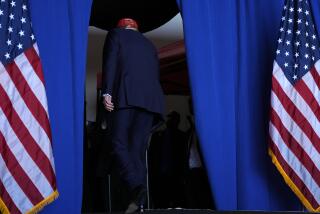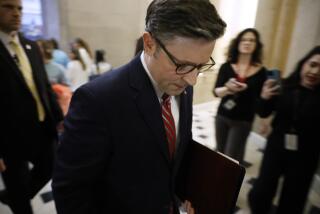GOP Takes One Step Forward, One Step Back
WASHINGTON — John G. Roberts Jr. is in. Tom DeLay, at least temporarily, is out.
That contrast encapsulates the uneven advance of Republican Party efforts to build a lasting conservative majority in U.S. politics.
After the 2004 election, which consolidated their hold on the White House and Congress, Republicans have suffered through a year of missteps and bad news -- such as this week’s indictment of DeLay, the House majority leader from Texas -- that have stirred Democratic hopes of a revival.
And yet, even as poll numbers sag for the GOP, Republicans continue to entrench their control of federal power -- a progression spotlighted by Thursday’s lopsided Senate confirmation of Roberts, who as chief justice may tilt the Supreme Court rightward for a quarter century or more.
These dueling developments capture a Republican ascendancy that looks enduring from some angles and fragile from others -- like concrete that hasn’t quite set.
In some respects, the GOP appears close to establishing a lasting political edge -- not seen since the days of President McKinley more than a century ago -- with interlocking advantages that create formidable barriers to a Democratic resurgence.
But approval ratings in polls for the GOP-controlled Congress and President Bush are similar to those for the Democratic-controlled Congress and President Clinton prior to the 1994 electoral landslide that put the GOP in charge of the House and the Senate.
“Clearly, the majority doesn’t seem to be as stable as [Republicans] thought, but whether this is a blip and doesn’t rearrange the fundamental structural foundations for a Republican edge is still to be answered,” said Andrew Taylor, a political scientist at North Carolina State University and author of the new book “Elephant’s Edge: The Republicans as a Ruling Party.”
The biggest cause for Republican optimism is a series of long-term political and demographic changes that have strengthened their position.
The most important may be the continued shift of population toward the Southern and western red states where the GOP is strongest. After the 2000 census, seven electoral college votes shifted from blue states that Democratic presidential candidate Al Gore won that year to states that Bush carried.
Demographer William Frey has calculated that the states Bush won in 2004 will gain another four electoral college votes after the 2010 census. Long-term population projections show the tilt continuing with big gains likely in Texas, Arizona and Florida -- each of which Bush carried handily.
These population shifts increase the pressure on Democrats to recapture culturally conservative states where they have struggled in presidential races since the 1960s.
A second political trend has multiplied the value of this first dynamic for the GOP. As partisan loyalties harden, each party is taking more House and Senate seats in the states that favor its candidate in presidential races. This has boosted the GOP’s prospects of holding the House and the Senate.
Each party controls about three-fifths of the House seats in the states it carried in the last two presidential elections. Just as the population tilt is fueling electoral college gains for the GOP in their Sun Belt strongholds, it is also increasing those states’ representation in the House.
Republicans hold 141 seats from the states Bush carried in 2000 and 2004, while Democrats hold 128 from the states carried by Gore and Sen. John F. Kerry (D-Mass.) -- a narrow, but crucial, advantage.
And in the Senate, each party controls about three-fourths of the Senate seats in states that it carried in the last two presidential elections.
Bush, primarily because of the GOP’s strength in small Midwest and western states, won 29 states in the last two elections, compared to 18 for Democrats. In the states Bush won twice, Republicans control 44 of the 58 Senate seats, enough to place his party on the brink of a majority even before it begins contesting seats elsewhere.
In both chambers, as in the electoral college, these trends mean Democrats are unlikely to recapture a majority unless they can crack the Republican dominance in red-leaning states.
“Republicans only have to win home games,” said Matthew Dowd, chief strategist for Bush’s 2004 campaign. “Democrats have to win all their home games and away games too. That’s the difficulty.”
Money represents another hurdle for Democrats, especially in congressional contests where Republicans are able to marry the advantages of incumbency with ideological affinity for business interests. In House races, the GOP out-raised Democrats nearly 4 to 3 in the last cycle. So far this year, Republican committees have out-raised their Democratic counterparts about 3 to 2.
In the 2006 midterm elections, the key question is likely to be whether a tide of disapproval over the country’s direction will reach high enough to wash away the GOP’s strengths, sweeping Republicans from the majority in one or both chambers.
Democrats generally remain cautious but see increasing reasons for optimism.
Amid the discontent over the war in Iraq, gas prices and, more recently, the response to Hurricane Katrina, the approval rating for Congress has been stuck in the low- to mid-30% range. Bush’s approval rating has sagged to 45% or lower in most surveys, among the lowest for a president in the first year of his second term. Among independents, approval ratings for Congress and Bush are especially bleak.
“In the center, sentiment is consolidating against the Republicans,” said Democratic-leaning analyst Ruy Teixeira at the Center for American Progress, a liberal think tank.
“Democrats have a lot of issues they can work with,” said Merle Black, a political scientist at Emory University in Atlanta. “But right now, about the only thing the Republicans have going for them is distrust of the Democrats.”
But few analysts in either party believe the Democrats have generated enough public confidence to fully benefit from this discontent.
Many Republicans privately acknowledge the party’s position for 2006 will remain precarious if the GOP-led Congress and Bush cannot improve their poll ratings.
In their own ways, DeLay and Roberts symbolize different paths for the GOP as it tries to recover public support.
Although popular with conservatives, Roberts wasn’t nearly as much a red flag for Democrats as other names Bush considered for the high court; in the end, he attracted significant support across party lines, both in polls and in Thursday’s Senate vote.
DeLay, by contrast, has always personified the strategy that focuses on energizing core Republicans with staunchly conservative positions -- even at the price of infuriating Democrats and potentially antagonizing independents. That approach, which largely has guided Bush’s political strategy, paid dividends for the GOP when huge turnout from its base voters were key to the party’s gains in the 2002 and 2004 elections.
But this year has underscored the risks of such an approach. Several of the initiatives popular with the GOP base -- such as Bush’s plan to restructure Social Security -- have sparked resistance from other voters. And because the electorate has been so polarized, Bush and Congress lacked a cushion of goodwill when dissatisfaction grew over Iraq and gas prices.
Now they face the opening of an election season with their support standing well below the 50% level usually considered the critical measure of political health.
“The problem with this [polarization] strategy is you leave yourself too little margin for error, and when things go bad, you can die by that strategy as well as live by it,” said Taylor, the political scientist at North Carolina State University.
More to Read
Get the L.A. Times Politics newsletter
Deeply reported insights into legislation, politics and policy from Sacramento, Washington and beyond. In your inbox three times per week.
You may occasionally receive promotional content from the Los Angeles Times.










